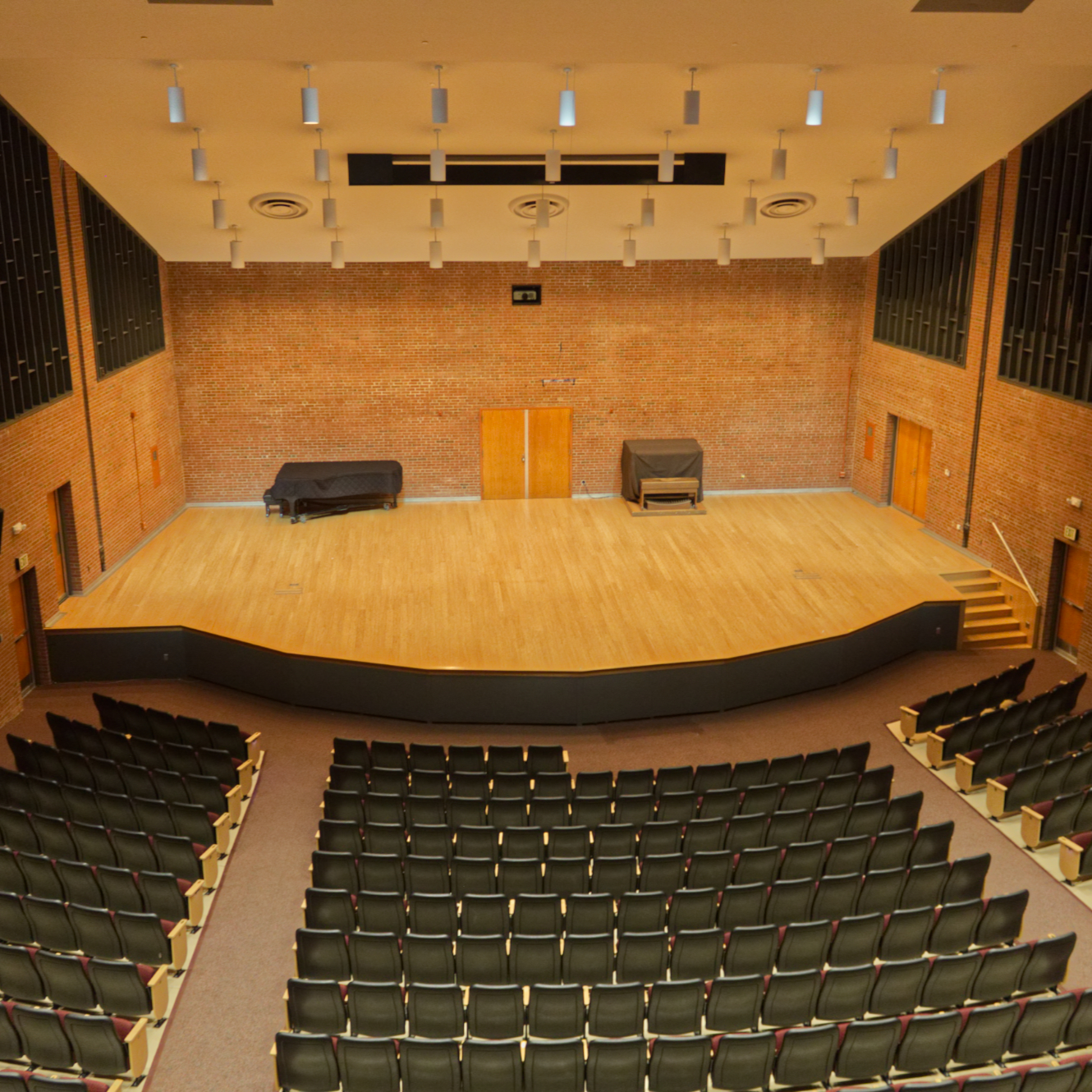
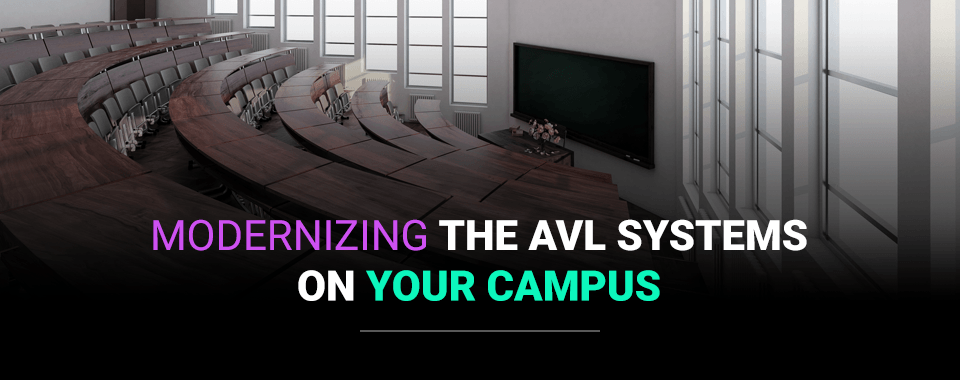
Your campus acts as an epicenter for growth. Professors mold the minds of tomorrow. Researchers make dynamic advancements in the fields of technology, medicine and science. Students develop the knowledge and skills they need to create the futures they desire. Your campus is an indispensable resource for thousands of men and women — do the AVL systems on your campus enable these students, researchers and faculty members to achieve their full potential?
An AVL system is a key resource you should not overlook for your college campus — especially the lighting component. Adequate lighting not only increases the safety and functionality of the campus, but it can also provide several physical and cognitive benefits that dramatically enhance the learning experience. However, an inefficient system can hinder productivity, limit knowledge retention and negatively impact the body’s circadian rhythm cycles. By modernizing AVL systems on campus, you can provide the best possible lighting for academic achievement.
The light around us continually impacts our bodies. As humans evolved, the systems in our bodies became reliant on daily cycles of natural light. However, these systems, specifically our circadian rhythms, can get significantly disrupted by exposure to artificial lighting. Without regulated periods of light and darkness that keep our bodies on a consistent cycle, our physiology can be adversely affected on a cellular level. Ineffective lighting systems on college campuses can cause physical harm to students, faculty and visitors.
One of the most significant impacts artificial lighting can have on an individual is the disruption of melatonin production. As natural daylight decreases, the body’s internal clock begins to release melatonin to promote sleep. The presence of artificial lighting can prevent this chemical release or even cause the body to produce melatonin at incorrect times, such as during a class lecture or presentation, thus directly impacting a student’s ability to perform in the classroom. Other ways artificial light can negatively affect our bodies include:
Thankfully, modernized lighting systems can create the ideal lighting environment that minimizes physiological impact. Perhaps one of the most noticeable benefits of proper lighting is the decrease in eye strain. A dim light source prevents us from seeing, while too strong of a light source can cause glare and discomfort in the eyes. Not only can a lighting system deliver the right amount of light for optimal vision, but it can also positively support the body’s natural circadian rhythm cycles.
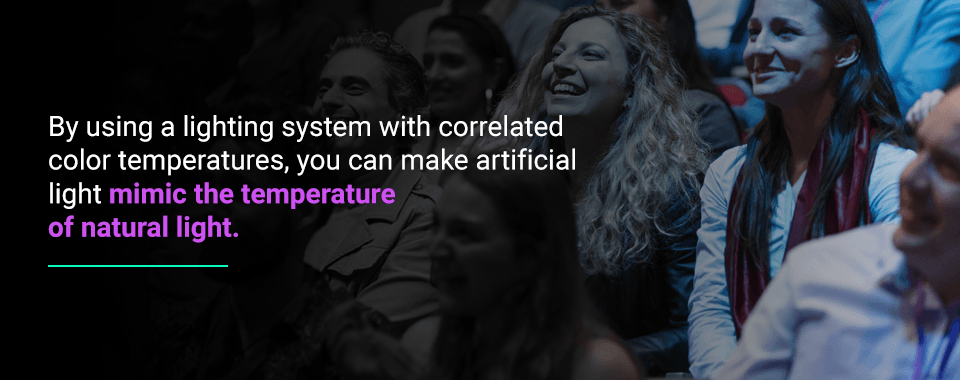
The three primary temperatures of light are cool, mid and warm. By using a lighting system with correlated color temperatures, you can make artificial light mimic the temperature of natural light. For example, scientists measure fluorescent light at 5,000 degrees Kelvin, which simulates daylight. Meanwhile, the color of sunlight at noon is slightly lower, at 4,800 degrees Kelvin, and the temperature of natural light on an overcast day is 7,500 degrees Kelvin. Controlling the color temperature of your lighting system can create light temperatures that minimally disrupt the circadian rhythm systems.
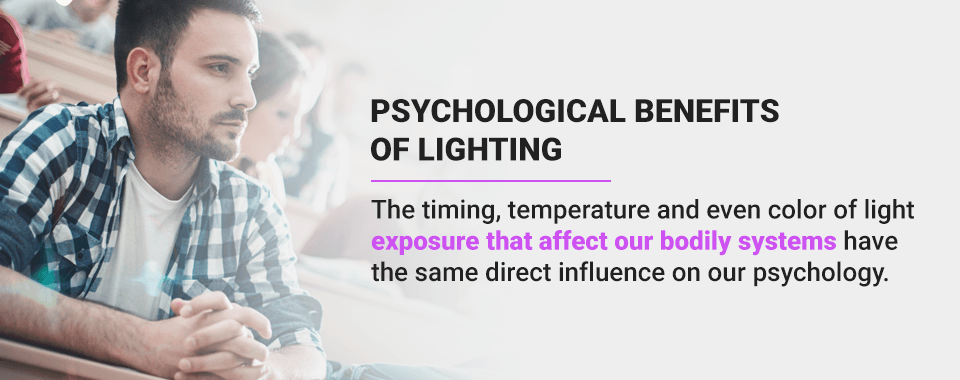
With such a significant impact on our physiology, it should come as no surprise that light sources substantially affect our mental health as well. Research into the effects of lighting on the brain has shown the light source of any room, such as a classroom or lab, can positively or negatively impact an individual’s mental state. The timing, temperature and even color of light exposure that affect our bodily systems have the same direct influence on our psychology.
In the same way some people experience seasonal affective disorder due to changes in periods of natural daylight, changes in the intensity and frequency of artificial light can also cause drastic mood shifts. Chronic levels of artificial light during night hours can impact individuals of all ages. Even a single night of aberrant light exposure is enough to influence mood changes, which means late-night employees or students studying on campus throughout the night are at risk of developing mood disorders from lighting.
The temperature and color of artificial lighting also have a psychological impact on students, faculty and researchers. In appropriate settings, the temperature of the light source can create ideal environments for those on campus. Lighting temperatures that fall below 4,000 degrees Kelvin can produce a calming effect that may decrease productivity. However, colder temperatures above 5,000 degrees Kelvin can positively increase mood, alertness and productivity. By controlling the lighting temperature within the buildings of your campus, you can ensure each space does not hinder positivity or productivity.
Aberrant light exposure, which is increasing in frequency due to the presence of light from technology, does not have to be harmful to the body or mind. It’s easy to modify many artificial lighting sources to create the desired environment for those working or studying on campus. For instance, install tunable white lighting in classrooms, research centers and faculty offices. Manually or automatically adjust these lights throughout the day to change the temperature of the light for optimal results.
By modernizing the AVL systems on your campus, you can control the way light impacts the mood and comfort level of those who visit, study and work at your institution. Color tuning allows you to limit the light temperature that impacts a space — tunable white lighting will enable you to continually modify the color temperature in a room to create an environment which minimally interferes with the body’s hormones that may induce stress, depression, anxiety or other psychological disruptions.
As artificial light sources influence psychological well-being, they also impact cognitive performance. There is no doubt natural light greatly benefits both students and faculty members in an academic environment. Although it is a critical resource for improving productivity, cognitive performance and psychological well-being, unfortunately, many institutions find themselves limited in the ways they can integrate more daylight into their interior spaces. As an alternative solution, many schools are implementing modernized lighting systems into their facilities to enhance the learning experience as much as possible.

Studies have shown that specific light temperatures have a positive impact on academic performance. The intensity of the light in classrooms, study halls or labs can affect students’ level of concentration. Also, inadequate lighting environments can affect those with learning disabilities in different ways that may more severely impact their ability to focus or perform well during tests. Universities can mitigate these challenges by creating an effective lighting environment that caters to academic performance.
If your institution is still using an outdated lighting system throughout the campus facilities, you may want to consider modernizing your AVL system. Modernized lighting systems can help students concentrate on their studies, retain information and interact with campus lighting in ways that do not negatively impact their mental or physical health. Although the main focus of an educational institution should be to provide students with the ideal environment that fosters learning and growth, it’s vital to understand the many factors that contribute to this goal.
Your campus is more than just the student body. Researchers, professors and faculty members are critical to the success of the student population. Many of these professionals may spend more time on campus than students. By updating your AVL system with modernized lighting techniques, you’re providing a better environment for these individuals, too. Modernized lighting is an investment in the success of your students, as well as the productivity and effectiveness of your faculty.
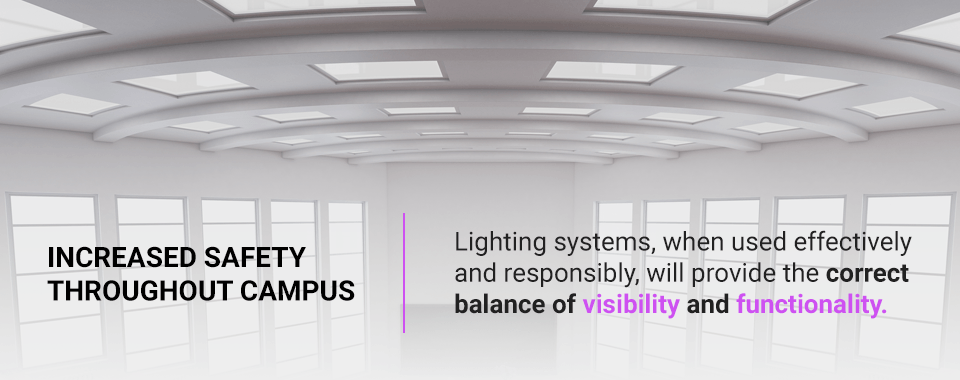
No matter the size or scope of your educational institution, the primary objective of your facility is to optimize the learning experience in every way possible. Lighting has an immediate impact on physiology and cognition. However, it also can directly enhance or hinder the learning experience in another critical way. Lighting has a significant correlation to the real and perceived safety of the campus. This resource can contribute to or diminish the level of safety and security students, faculty members and visitors feel.
Throughout all hours, thousands of men and women spend time on your campus. Whether the custodial crew is working into the late hours of the night or students are rising before the sun to begin their day, all individuals on campus should be able to safely work, study and live on school grounds. Modernizing lighting increases the security and safety on college campuses. Universities across the country are taking proactive steps to enhance the security of their schools via modernized lighting systems.
There are many instances in which a modernized lighting system could increase campus safety. Outdoor lighting can illuminate walkways and wayfinding signage, minimize areas cloaked in shadow, provide ample lighting for security cameras, increase visibility in parking lots and assist personnel who are responding to emergencies on campus. A significant benefit of advanced interior lighting is that users can program it to only provide full illumination when a room is occupied. That alerts campus security to the presence of individuals in a building during late night hours.
Although the presence of modernized lighting systems may deter crime and provide a safer facility for guests, it’s also important to keep in mind that lighting can dramatically impact the perceived level of safety and security visitors feel on campus. Students have reported the lighting on campus and within parking lots has a stronger influence on their perception of campus safety over many other relevant factors, such as:
Take a moment to consider all the regular activity on your campus. Facility maintenance personnel, faculty members and students may be walking around the grounds or buildings at every hour. Even if you believe your current lighting systems are adequate, it’s important to realize the presence of bright lights does not automatically increase safety. Too much lighting can also hinder vision and fail to prevent criminal activity from occurring. Lighting systems, when used effectively and responsibly, will provide the correct balance of visibility and functionality.
Regardless of whether your campus is vast or compact, it’s likely your facility plays host to many diverse events throughout the year. Now that you understand how light temperature can impact the attentiveness, mood and safety of those in attendance, you can apply this knowledge to enhance the special events that take place across campus. From concerts and sporting events to carnivals, worship services and more, integrating a versatile AVL system into your campus facilities allows you to provide appropriate lighting for every event.
Even used separately from special events, lighting on college campuses can also enhance the appearance of the buildings and grounds throughout the year. Universities and colleges have tactfully incorporated a lighting system into their school’s branding initiative. Using lighting that mimics the school’s colors, these systems reinforce the distinctive brand while providing a practical application. This AVL system can blend into the exterior design and become a standard aesthetic feature that upholds the brand throughout the entire campus.
Integrating a lighting system into a standardized design scheme for campus architecture can also act as a reference guide for those interacting with the campus. Small lighting sources like bollards can be wayfinding devices that lead pedestrians toward their destination. Special lighting techniques can showcase entrances to buildings or highlight gathering areas. Implement responsive lighting to allow an area — for instance, a service entrance for authorized personnel only — to remain relatively concealed until triggered lighting illuminates the space when in use.
How do you want an individual to view your institution when they step onto campus for the first time? As a center for academia, athletics and special events, you want to present a positive first impression for the many visitors that interact with your school. A lighting system is a fantastic resource that can enhance the events that take place across campus in practical and artistic ways. By modernizing this system, you can showcase your campus in a bright, functional and appealing light.
Perhaps most importantly, a lighting system is easily integrated into new or existing audio and video systems. An updated AV system is vital for a college campus, and AV trends are driving the way professors, students and researchers teach, learn and interact with each other in-person and remotely.
Colleges around the country are upgrading their current AVL systems to follow these dynamic AVL trends:
AVL systems also complement wireless technology, which is increasingly prevalent on university and personal student devices. Many college campuses want to run their AV off of their singular network, replacing historical AV setups with AV over internet protocol (IP), which means AVL systems are a growing necessity on your campus.
As more and more colleges and universities integrate dynamic AVL systems into their campus networks, campuses without dynamic AVL systems will not be able to offer the quality and functionality that current and potential students will expect.
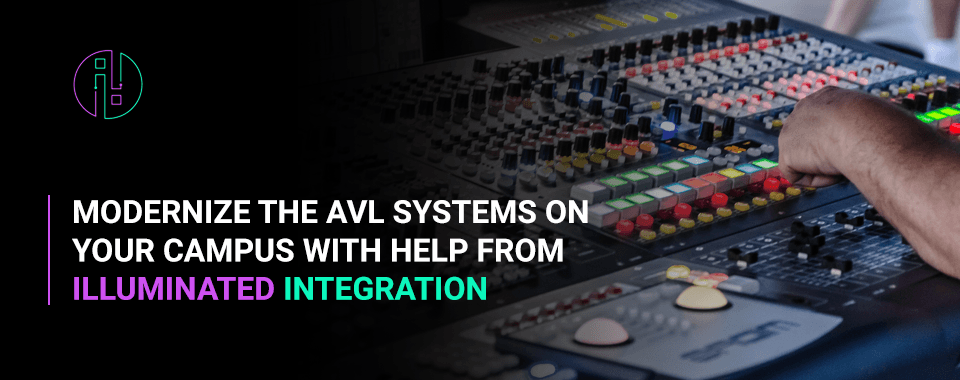
Campus AVL systems are vital resources that need to perform effectively and efficiently at all times of the day and night. The lighting component of these systems is perhaps the most important, as it can directly impact the learning experience as well as the health, safety and security of those working, enrolled or visiting your campus. By modernizing the lighting on and around campus, you can provide the maximum benefit possible for students, employees and guests. Let Illuminated Integration upgrade the AVL systems in your educational institution today.
Modernizing the lighting and other AVL systems on your college campus is easy with help from Illuminated Integration. We believe these systems should provide the ideal atmosphere that optimizes the learning experience, increases campus safety and positively impacts the health of those who attend your institution. The professionals at Illuminated Integration can successfully help you enhance your campus buildings, walkways and parking lots with modernized lighting systems. To learn more about the ways modern AVL systems can improve your campus, call Illuminated Integration today.